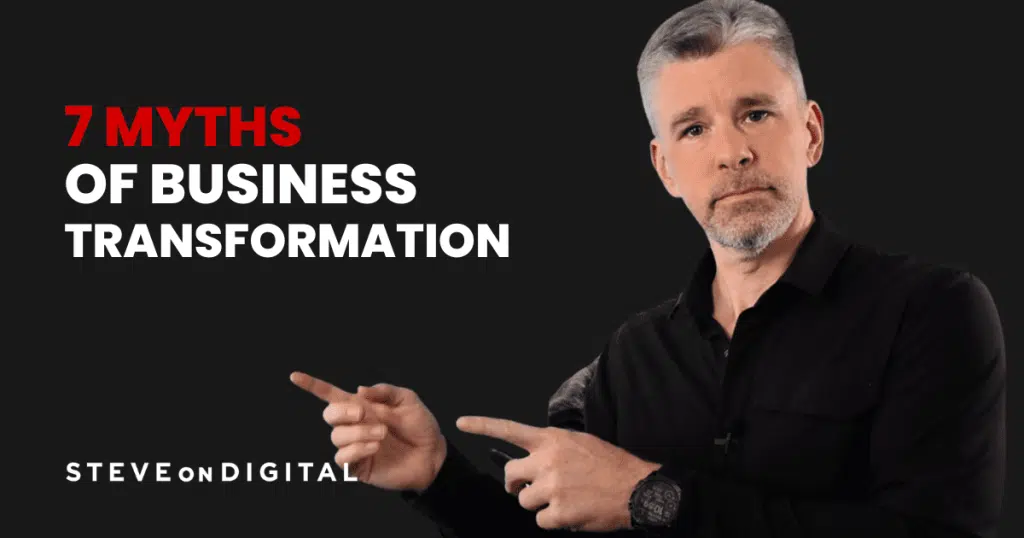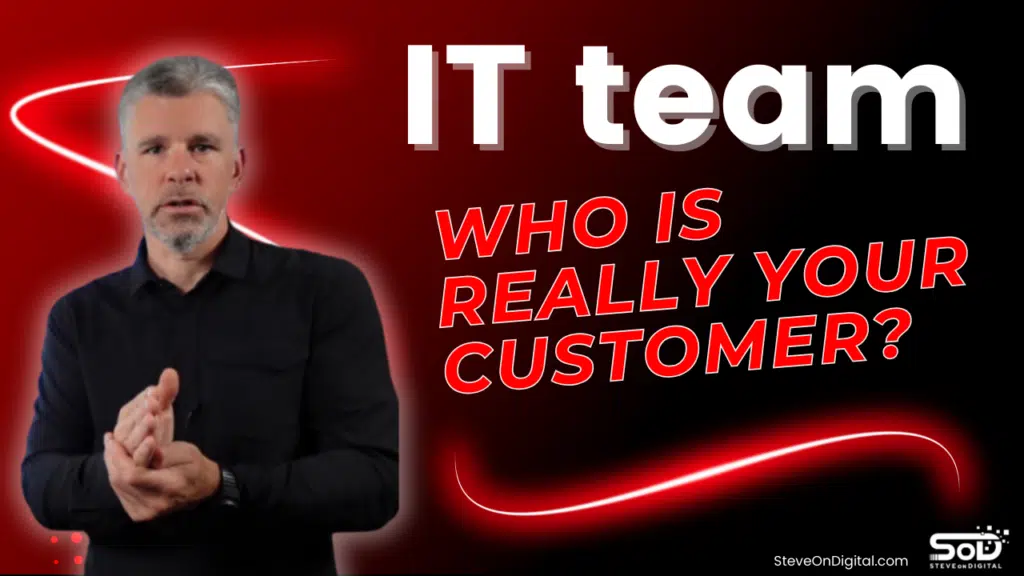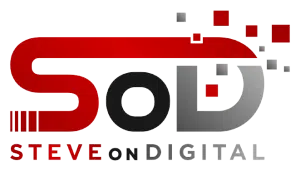Essential Digital Tools For Successful Business Transformation | SteveOnDigital

Digital tools are essential for driving successful digital transformation. Utilizing the best digital transformation tools can help businesses automate processes, enhance customer interactions, and improve overall efficiency. Using the right tools can streamline operations and provide valuable insights that lead to better decision-making and business growth. In today’s fast-paced digital era, standing still means falling behind. I’ve seen firsthand how implementing digital tools can transform businesses, making them more competitive and resilient. It’s not just about adopting new technologies but about changing how you operate and deliver value to your customers. I’m Steve, a digital transformation expert with a strong background in electrical engineering, an MBA, and a master’s in Project Management. I excel at helping SMEs navigate the digital landscape with practical insights. Let’s begin! Understanding Digital Transformation Tools When I talk about digital transformation tools, I’m referring to the technologies that empower businesses to modernize their operations. These tools are the building blocks of digital transformation, enabling businesses to streamline operations, enhance customer interactions, and drive growth. But before we dive into the specific tools, let’s take a closer look at what these tools are and why they’re so essential for digital business transformation. What Are Digital Transformation Tools? Digital transformation tools are software and platforms that help businesses transition from traditional processes to digital ones. These tools support various aspects of a business, from managing customer relationships to automating repetitive tasks. A content management system (CMS) is crucial for executing an effective content strategy, as it streamlines content creation, editing, and publishing. Think of them as the gears that keep your digital transformation strategy running smoothly. Whether it’s project management tools, digital accounting tools, or CRM systems, each plays a critical role in driving a successful digital transformation. For example, CRM systems are vital for managing customer interactions. They help businesses track and analyze every touchpoint with a customer, improving customer retention and satisfaction. Meanwhile, digital accounting tools automate financial processes, reducing errors and freeing up time for more strategic tasks. These tools aren’t just nice to have; they’re essential for businesses that want to stay competitive in the digital era. Benefits of Using Digital Tools in Transformation The benefits of integrating digital tools into your business are immense. Digital workplace suites are comprehensive solutions designed to integrate various tools, enabling companies to create a collaborative and efficient digital office environment. First and foremost, these tools help you automate processes, which means you can focus on growing your business instead of getting bogged down by manual tasks. I’ve seen how digital tools can streamline operations, leading to faster and more accurate business processes. For instance, digital accounting tools can significantly reduce the time spent on bookkeeping, allowing you to invest more energy into strategic decision-making. Another key benefit is the ability to gain valuable insights from data. Tools like business intelligence software gather and analyze data from various sources, helping you make informed decisions. These insights can reveal patterns in customer behavior, inefficiencies in your operations, and opportunities for growth. By applying these insights, you can refine your digital transformation strategy and achieve improved business outcomes. Challenges in Adopting Digital Tools Adopting digital tools as part of a digital initiative isn’t without its challenges. I’ve worked with many small businesses that struggled with the transition. Common obstacles include resistance to change, a lack of technical expertise, and the upfront costs associated with new tools. However, these challenges are surmountable with the right approach. One of the biggest hurdles is getting your team on board. Change can be intimidating, especially when it involves learning new technologies. But by investing in digital adoption platforms, you can ease the transition for your employees. These platforms provide training and support, helping your team become comfortable with the new tools and processes. Another challenge is the potential for a steep learning curve. Digital tools often come with a wealth of features, which can be overwhelming at first. I recommend starting small—focus on the tools that will have the most significant impact on your business and gradually expand from there. This approach allows you to build digital maturity at a pace that suits your business. Essential Digital Tools for Successful Digital Transformation Digital transformation initiatives are only as effective as the tools you use. Over the years, I’ve seen businesses thrive by selecting the right digital tools that fit their specific needs. These tools are not just about keeping up with the latest trends—they’re about driving real, measurable improvements in your business operations. Let’s take a look at some of the most critical digital tools that can support a successful digital transformation strategy. Cloud Computing Cloud computing has revolutionized the way businesses operate. It’s no longer necessary to rely on physical servers or localized storage. Instead, you can harness the power of the cloud to store, manage, and access your data from anywhere. Cloud computing plays a pivotal role in digital transformation by providing flexibility, scalability, and cost-effectiveness. By shifting to cloud-based solutions, businesses can reduce overhead costs and enhance collaboration across teams. Additionally, cloud computing offers essential tools to support digital transformation, optimizing operations and enhancing competitive advantages. Cloud Storage Services One of the first steps in embracing cloud computing is moving your data to cloud storage services. These tools offer secure, reliable storage for all your business data. I’ve found that cloud storage tools like Google Drive, Dropbox, and Microsoft OneDrive are invaluable for ensuring that critical business information is accessible to those who need it, when they need it. The benefits are clear: enhanced data security, real-time collaboration, and the ability to scale storage as your business grows. Cloud-Based Office Suite In the past, collaborating on documents often meant emailing files back and forth—a tedious and error-prone process. Today, cloud-based office suites like Microsoft 365 and Google Workspace make this a thing of the past. These tools enable teams to work together in real-time, no matter where they are. I’ve seen how businesses can drastically improve productivity by adopting
Business Model Canvas | There Is More Than You Know

The Business Model Canvas (BMC) is a visual tool to help describe, design, and pivot your business model. It simplifies the complex elements of a traditional business plan into a single page with nine key components, making it easier to define and evaluate a business idea. Using the BMC can enhance strategic planning and business management by providing a clear, shared understanding of your business model. It helps identify gaps, promote innovation, and adapt to market changes. I’ve found it invaluable for maintaining a flexible and up-to-date strategy, crucial for staying competitive in today’s fast-paced business environment. I’m Steve, a digital transformation expert with a strong background in electrical engineering, an MBA, and a master’s in Project Management. I excel at helping SMEs navigate the digital landscape with practical insights. Let’s begin! Business Model Canvas The Business Model Canvas (BMC) is a strategic management tool that offers a visual framework to describe, design, challenge, and pivot your business model. Business model canvas explained: It is a tool for developing and improving business ideas, known for its simplicity and effectiveness as a one-page technique to aid in planning. Created by Alexander Osterwalder and Yves Pigneur, it simplifies the complexities of a traditional business plan into a single page, divided into nine essential elements. This visual format allows you to see all the critical components of your business at a glance, making it easier to understand, communicate, and manage your strategy. Importance of Using a Business Model Canvas Using the BMC has several advantages. Firstly, it provides a clear, shared understanding of your business model among your team, fostering better communication and collaboration. Secondly, it helps in identifying gaps and opportunities for improvement, promoting innovation. Finally, the BMC is flexible and can be updated regularly to adapt to changes in the market or your business environment, which is crucial for staying competitive. Key Components of the Business Model Canvas The BMC is made up of nine building blocks that represent the core aspects of a business. The business model canvas template serves as a strategic planning tool that simplifies and illustrates these key elements. Understanding these elements will help you create a comprehensive and effective business model. Explanation of the Nine Building Blocks 1: Key Partnerships Key partners are crucial for the success and growth of any business. They help you leverage other companies’ strengths to achieve your objectives more efficiently. Definition and Importance of Key Partnerships Key partnerships involve collaboration with other businesses or entities that complement your business model. These partnerships can reduce risks, improve operations, and provide access to additional resources and capabilities. Types of Key Partnerships Type Description Strategic Alliances Partnerships with non-competitors to achieve common goals Joint Ventures Collaborative agreements to develop new businesses Supplier Relationships Long-term engagements with suppliers to secure reliable access to resources Buyer-Supplier Relationships Strategic alliances to ensure the availability of crucial inputs for your business How to Identify and Develop Key Partnerships Identifying and nurturing key partnerships involves a few strategic steps: 2: Key Activities Key activities are the critical actions that your business must undertake to operate successfully. Definition and Examples of Key Activities Key activities include the essential tasks that must be performed to create and deliver your value proposition, reach your markets, maintain customer relationships, and earn revenues. Examples include: Aligning Key Activities with Business Goals It’s important to ensure that your key activities are aligned with your business goals. This alignment helps in maximizing efficiency and achieving strategic objectives. For instance, if your goal is to improve customer satisfaction, key activities might include enhancing customer service and streamlining the product delivery process. Optimizing Key Activities for Efficiency To optimize key activities, focus on: 3: Key Resources Understanding Key Resources Key resources are the assets that are essential for your business to deliver its value proposition, reach its markets, maintain customer relationships, and earn revenue. These resources are the backbone of your business model, ensuring you have what you need to operate effectively and efficiently. Types of Key Resources Key resources can be categorized into four main types: Managing and Acquiring Key Resources Effective management and acquisition of key resources are critical for sustaining business operations and growth. Here are some best practices: 4: Value Propositions Defining Value Proposition A value proposition is the distinct benefit a company provides to its customers through its products or services. It answers the fundamental question: why should customers choose your business over competitors? The value proposition is the heart of your business model canvas and drives all other elements. Crafting a Strong Value Proposition Creating a compelling value proposition involves understanding your customers’ needs and how your products or services meet those needs uniquely. Here are some tips: Examples of Effective Value Propositions 5: Customer Segments Identifying Customer Segments Customer segments are the different groups of people or organizations your business aims to reach and serve. Identifying these segments helps tailor your value proposition, marketing efforts, and customer relationships to meet the specific needs of each group. Importance of Targeting the Right Customer Segments Targeting the correct customer segments is crucial because it ensures your efforts and resources are focused on the most profitable and receptive groups. This targeted approach enhances marketing efficiency, customer satisfaction, and overall business success. Techniques for Analyzing Customer Segments 6: Customer Relationships Types of Customer Relationships Businesses can establish various types of relationships with their customers, ranging from personal to automated: Building and Maintaining Customer Relationships Building and sustaining strong customer relationships is vital for customer retention and loyalty. Here are some strategies: Impact of Customer Relationships on Business Growth Effective customer relationships directly contribute to business growth by increasing customer satisfaction and loyalty. Satisfied customers are more likely to make repeat purchases and recommend your business to others, driving new customer acquisition and boosting revenue. 7: Channels Overview of Distribution Channels Channels are the various ways your business delivers its value proposition to its customer segments. These channels play a crucial role in reaching
Key Benefits Of A Document Management System For Small Businesses

A Document Management System (DMS) can streamline the way you store, manage, and retrieve important documents, making your business more efficient and secure. It’s essential for any business looking to save time, reduce costs, and ensure that critical documents are always accessible. Implementing a DMS has been transformative for my business. I’ve seen firsthand how it simplifies daily operations by organizing both paper and digital documents into a single, easy-to-use system. If you’re looking to enhance productivity and stay ahead in a competitive market, a DMS is a must-have tool. I’m Steve, a digital transformation expert with a strong background in electrical engineering, an MBA, and a master’s in Project Management. I excel at helping SMEs navigate the digital landscape with practical insights. Let’s begin! What Is A Document Management System? Let’s start with the basics. A Document Management System is more than just a tool to store your files—it’s a comprehensive system designed to manage and organize documents efficiently. Whether you’re dealing with digital documents or physical paper documents, a DMS ensures that everything is in its rightful place, accessible with just a few clicks. In a world where time is money, having quick access to your critical documents can significantly boost your productivity and efficiency. Definition And Overview In simple terms, a Document Management System (DMS) is software that helps you manage, store, and track your electronic documents. It’s a bit like having a super-organized filing cabinet, but without the hassle of digging through drawers or dealing with misfiled documents. A DMS allows you to store everything from Microsoft Word files to digital images, making it easier to find documents when you need them. It’s particularly useful in reducing the time-consuming process of document retrieval, which can be a real headache in a busy office environment. Key Components Of A DMS A DMS is built on a few key components that work together to make document management seamless. The software is the heart of the system, providing the interface you’ll use to manage your documents. Then there’s the hardware, which might include servers or cloud storage solutions that store your data. Speaking of the cloud, cloud-based DMS options have become increasingly popular because they allow you to access your documents from anywhere, at any time. This flexibility is a huge advantage, especially for businesses with remote teams or multiple locations. Types Of Document Management Systems When it comes to choosing a DMS, you have several options. On-premise systems are hosted on your own servers, giving you complete control but requiring a significant upfront investment in hardware. Cloud-based systems, on the other hand, are hosted by a third party, which means lower initial costs and easier scalability. There’s also a hybrid option, which combines the best of both worlds, offering the security of on-premise with the flexibility of cloud storage. Each type has its own set of advantages, and the right choice depends on your business’s specific needs. Importance Of Document Management Systems Why should you care about a DMS? The answer is simple: it’s crucial for your business’s growth and sustainability. As your business expands, so does the volume of documents you need to manage. Without a proper system in place, you’ll find yourself buried under a mountain of paper documents and digital files, wasting precious time and resources. A DMS not only helps you stay organized but also plays a vital role in your business’s digital transformation, allowing you to scale efficiently. Digital Transformation And Scalability One of the biggest benefits of a DMS is its role in digital transformation. In today’s fast-paced business environment, going digital isn’t just an option—it’s a necessity. A DMS allows you to transition from paper documents to digital documents, streamlining your workflows and making it easier to manage your growing business. As your company scales, a DMS grows with you, accommodating new documents, users, and processes without missing a beat. Enhancing Efficiency And Productivity Imagine being able to find any document you need within seconds. That’s the power of a DMS. By centralizing your document storage and making it easily searchable, a DMS drastically reduces the time spent on document retrieval. This increase in efficiency translates directly into higher productivity. No more searching through file cabinets or dealing with misfiled documents—everything you need is right at your fingertips. Regulatory Compliance In many industries, regulatory compliance is non-negotiable. Whether it’s keeping track of critical documents or ensuring that sensitive information is stored securely, a DMS can help you meet compliance requirements with ease. It allows you to set access controls, manage version histories, and maintain audit trails, all of which are essential for staying compliant with industry regulations. With a DMS, you can rest easy knowing that your documents are stored securely and are accessible only to those with the proper permissions. Key Benefits Of A Document Management System Implementing a Document Management System (DMS) has been one of the best decisions I’ve made for my business. The benefits extend far beyond simple file storage. It’s about creating an organized, efficient, and secure environment where documents can be accessed and managed seamlessly. Let me walk you through some of the key advantages that I’ve personally experienced with a DMS. Improved Document Accessibility One of the first things I noticed after implementing a DMS was how much easier it became to access important documents. Before, finding a specific document was like searching for a needle in a haystack—especially when dealing with physical documents. But with a DMS, everything is stored digitally and can be retrieved with a simple search. Document Retrieval The process of retrieving documents has become almost instantaneous. Whether it’s a digital document or an electronic document management system file, I can find what I need in seconds. This streamlined retrieval process has saved me countless hours that would have otherwise been wasted rummaging through file cabinets or misfiled documents. Enhanced Collaboration Another game-changer has been the way a DMS enhances collaboration. Multiple users can access and work
Myths Of Digital Transformation: What’s True And What’s Not

Many business owners hesitate to start digital transformation because they believe common myths. These misconceptions can make the process seem more complex and overwhelming than it is in the digital age. Digital transformation is not just one project, nor does it require changing everything at once. It’s an ongoing journey that integrates new digital technologies into existing business processes. The strategic integration of digital technology is crucial for fundamentally enhancing operations and customer experiences. Understanding and debunking these myths can help you embrace digital transformation successfully, ensuring that your business stays competitive and meets evolving customer expectations. I’m Steve, a digital transformation expert with a strong background in electrical engineering, an MBA, and a master’s in Project Management. I excel at helping SMEs navigate the digital landscape with practical insights. Let’s begin! Common Myths of Digital Transformation Many business owners hesitate to embark on their digital transformation journey due to common misconceptions. These myths can create unnecessary fears and misaligned expectations, making the process seem more daunting than it really is. In this section, I’ll debunk these myths to provide a clearer understanding of what digital transformation truly entails. Myth 1: Digital Transformation Is Just One Project One of the most pervasive myths about digital transformation is that it’s a single, massive project with a clear beginning and end. The truth is far from this simplistic view. Understanding the Digital Transformation Journey Digital transformation is not a one-time event; it’s an ongoing journey that involves multiple projects, phases, and adaptations over time. It’s about continuously evolving to meet new challenges and customer expectations. From my experience, I’ve seen businesses struggle when they treat digital transformation initiatives as a one-off project. Instead, think of it as a series of steps that require constant reassessment and adjustment. The Role of a Digital Roadmap To manage this ongoing journey, a digital roadmap is crucial. This roadmap breaks down the transformation into manageable steps, allowing for pauses and reassessments along the way. These pauses aren’t just idle times—they’re opportunities to evaluate progress, gather feedback, and make necessary adjustments. A well-thought-out roadmap ensures that the transformation aligns with your overall business objectives, keeping everyone on the same page. Myth 2: Digital Transformation Requires Everything to Change Another common misconception is that digital transformation means completely overhauling all existing processes. This myth often leads to unnecessary resistance within organizations, particularly among employees who are wary of change. Balancing Change and Continuity The reality is that digital transformation doesn’t require you to throw out everything that’s already working. Instead, it’s about integrating new technologies with existing processes and reimagining business models to enhance efficiency and meet evolving customer expectations. In my consulting work, I’ve found that the most successful transformations strike a balance between preserving effective practices and introducing new digital tools. Managing Resistance to Change Change, even when positive, often meets with resistance. This resistance can stem from fear of the unknown or concerns about job security. To mitigate this, it’s important to involve employees early in the transformation process, communicate clearly, and provide adequate training. When employees feel included and supported, they’re more likely to embrace the changes and contribute to the transformation’s success. Myth 3: Digital Transformation Takes Forever Many business owners believe that digital transformation is an endless process that drags on indefinitely, draining resources without delivering tangible results. This myth can be particularly discouraging, leading to hesitation in starting the transformation journey at all. Achieving Quick Wins While digital transformation is indeed an ongoing process, that doesn’t mean it has to take forever to see results. By identifying and focusing on quick wins—small, manageable projects that can be completed early on—you can build momentum and demonstrate the value of the transformation. These early successes not only boost employee morale but also help secure continued support from stakeholders. Communicating Progress Transparency is key to keeping everyone motivated throughout the transformation journey. Regularly communicating progress, celebrating milestones, and updating the digital roadmap as necessary helps maintain focus and ensure that the transformation doesn’t feel like an endless endeavor. In my experience, clear and consistent communication can make all the difference in keeping a transformation on track. Myth 4: Digital Transformation Only Leads to Gadgets There’s a misconception that digital transformation is all about adding the latest gadgets and gizmos to your business operations. This myth trivializes the strategic importance of digital transformation, reducing it to a mere tech upgrade. Involving Employees in Tool Selection Digital tools are indeed a critical component of transformation, but they’re far from being just “gadgets.” These tools are carefully selected to meet specific business needs, enhance efficiency, and improve customer experiences. Involving employees in the selection process ensures that the tools chosen are not only effective but also embraced by those who will use them daily. Maximizing Tool Utilization Once the right tools are selected, it’s crucial to maximize their utilization. This involves proper configuration, training, and ongoing support to ensure that employees can use the tools to their full potential. From my own experience, I’ve seen how effective training can turn initial skepticism into enthusiasm, leading to greater productivity and satisfaction. Myth 5: Digital Transformation Is All About Technology Another widespread myth is that digital transformation is solely about technology. This view overlooks the most important aspect of any business: its people. People-Centric Transformation While technology is a key enabler of digital transformation, the true driving force is the people who use that technology. The success of any transformation effort hinges on understanding and meeting the needs of employees and customers. I’ve always emphasized a people-first approach in my consulting work, and it’s consistently proven to be the most effective strategy. Technology as an Enabler Technology should be viewed as a tool that supports the transformation process, not as the end goal. It’s there to enhance operational efficiency, streamline business processes, and ultimately deliver better customer experiences. By keeping the focus on people and their needs, businesses can ensure that their digital transformation efforts lead to meaningful
Aligning IT With Business Goals: Prioritizing Business Outcomes In IT Strategies

Aligning IT with business goals is crucial for any organization aiming to succeed. By ensuring IT initiatives align with business objectives through business IT alignment as a strategic approach, companies can boost performance, drive innovation, and achieve growth. This alignment bridges the gap between technology and strategy, helping to deliver tangible business outcomes. Understanding business goals and objectives is the first step. Goals are the company’s long-term ambitions, like increasing market share or enhancing customer satisfaction. Objectives are specific, measurable steps that help achieve these goals. By aligning IT with these elements, businesses can optimize operations, improve efficiency, and enhance customer satisfaction. I’m Steve, a digital transformation expert with a strong background in electrical engineering, an MBA, and a master’s in Project Management. I excel at helping SMEs navigate the digital landscape with practical insights. Let’s begin! Understanding Business Goals and Objectives Defining business goals and objectives is the first step toward successful IT alignment. Goals are the overarching ambitions of a company, such as increasing market share or enhancing customer satisfaction. Objectives are specific, measurable steps that help achieve these goals. Defining Business Goals Business goals represent the long-term vision of a company. They provide direction and set the stage for strategic planning. For instance, a goal might be to become the market leader in a specific industry within five years. Identifying Business Objectives Objectives are more specific than goals. They are the actionable steps needed to reach those broader goals. For example, increasing annual revenue by 15% or reducing customer churn by 10% in the next year are clear objectives that support the overall business goals. The Role of IT in Achieving Business Outcomes Information technology plays a pivotal role in driving business outcomes by aligning IT with business strategy to ensure that IT systems effectively support overall business goals. Here’s how IT can influence key business outcomes: Enhancing Customer Satisfaction IT solutions can significantly improve the customer experience. For instance, implementing a robust CRM system can help manage customer interactions more effectively, leading to increased satisfaction and loyalty. According to a survey, companies with strong customer engagement strategies see a 55% higher customer retention rate (Planview). Improving Operational Efficiency Streamlining business processes through automation and advanced IT systems can lead to significant cost savings and productivity gains. For example, integrating ERP systems can optimize supply chain management, resulting in a 20% reduction in operational costs (ClearPoint). Driving Innovation and Growth IT enables businesses to innovate by providing tools and platforms that support the development of new products and services. Companies that prioritize IT alignment see a 77% increase in their ability to execute new growth strategies (ClearPoint). Developing an IT Strategy Aligned with Business Priorities Aligning IT strategies with business priorities is crucial for achieving success in today’s digital age. This section outlines a step-by-step guide on how to create an IT strategy that aligns seamlessly with the overall business strategy. Assessing Current IT Capabilities Before developing an IT strategy, it is essential to view it business alignment as an ongoing project that requires constant evaluation and communication between IT and business departments. This involves understanding the current capabilities and identifying gaps that need to be addressed. Steps to Assess Current IT Capabilities: Evaluating IT capabilities helps in understanding where the organization stands and what improvements are necessary to support business objectives. Setting IT Goals that Support Business Objectives Establishing IT goals that align with business objectives is essential for achieving strategic alignment. These goals should be specific, measurable, achievable, relevant, and time-bound (SMART). Steps to Set IT Goals: By setting aligned IT goals, you ensure that IT efforts are focused on achieving business outcomes. Creating an IT Roadmap An IT roadmap outlines the steps necessary to implement IT initiatives that align with business goals. It provides a clear path for achieving IT and business alignment. Steps to Create an IT Roadmap: Creating a detailed IT roadmap helps in planning and executing IT initiatives effectively, ensuring they contribute to business success. Step Description Define Key Milestones Identify major milestones needed to achieve IT goals. Develop a Timeline Create a timeline considering resource availability and dependencies. Assign Responsibilities Allocate tasks to specific teams or individuals. Monitor Progress Regularly track progress and adjust the roadmap as needed. Engaging Business Leaders and Stakeholders Involving business leaders and stakeholders in the IT alignment process is vital for gaining support and ensuring that IT initiatives meet business needs. It is essential to invite business leaders to engage in conversations about daily challenges and objectives, as this collaboration fosters a better understanding of business needs and enhances the alignment of IT with those needs. Building Trust with Business Leaders Establishing strong relationships and trust with IT leaders and business leaders is crucial for aligning technology strategies with business objectives. Strategies to Build Trust: Building trust with business leaders ensures their support and involvement in IT projects. Facilitating Open Communication Maintaining transparent and ongoing communication between IT and business teams is essential for successful alignment. Steps to Facilitate Open Communication: Open communication helps in ensuring that IT and business teams work together towards common goals. Ensuring IT and Business Processes Integration Integrating IT processes with business operations is key to achieving better alignment and efficiency. Aligning IT Projects with Business Processes IT projects should be designed to support and enhance business processes, ensuring they contribute to business goals. Steps to Align IT Projects: Aligning IT projects with business processes ensures that IT efforts are focused on improving business performance. Leveraging Technology for Business Process Improvement Technology can be a powerful tool for enhancing and optimizing business processes. Ways to Leverage Technology: Leveraging technology helps in optimizing business processes, leading to better alignment and increased efficiency. Measuring the Success of IT and Business Alignment To ensure that IT and business alignment is effective, it’s essential to measure its success using specific metrics and Key Performance Indicators (KPIs). These metrics help in evaluating how well IT initiatives support business goals and identifying areas for
Breaking Down Silos: Overcoming Barriers to Collaboration

Breaking down silos is essential for any organization aiming to improve collaboration and communication. Silos form when departments or teams operate independently, causing inefficiencies and missed opportunities. Addressing this issue can transform how a company operates, leading to better outcomes and increased productivity. I’ve experienced firsthand how detrimental silos can be. They create barriers between teams, hindering the flow of information and collaboration. By breaking down these silos, I’ve seen how organizations can foster a more unified, efficient, and innovative environment that benefits everyone involved. I’m Steve, a digital transformation expert with a strong background in electrical engineering, an MBA, and a master’s in Project Management. I excel at helping SMEs navigate the digital landscape with practical insights. Let’s begin! Understanding Organizational Silos Organizational silos are more than just physical barriers; they represent the divisions within a company that prevent the free flow of information, ideas, and collaboration. When I first started noticing silos within my own company, I realized how much they were holding us back. Silos can form for many reasons, but the end result is always the same: a fragmented organization where departments operate independently, often at the expense of the company’s overall goals. Definition of Organizational Silos Organizational silos occur when departments, teams, or even individuals within a company work in isolation from one another. This isolation can lead to a lack of communication, reduced collaboration, and ultimately, inefficiencies that hinder the organization’s ability to achieve its goals. In my experience, silos often develop subtly, as teams focus on their own objectives without considering the bigger picture. Before you know it, these silos have become entrenched, creating barriers that are difficult to break down. Types of Organizational Silos There are several types of organizational silos that can form within a company, each with its own unique challenges: Common Causes of Silos in Organizations Silos don’t just appear out of nowhere—they’re often the result of underlying issues within the organization. Based on my experience, here are some common causes of silos: The Impact of Silos on Business Performance Silos can have a significant impact on business performance, often in ways that aren’t immediately obvious. When departments operate in isolation, they miss out on opportunities to share knowledge, collaborate on projects, and align their efforts with the company’s goals. Over time, these missed opportunities can add up, leading to reduced productivity, lower employee morale, and ultimately, a negative impact on the company’s bottom line. Halted Data Flow One of the most significant impacts of silos is the disruption of data flow within the organization. When departments don’t share critical information, it creates blind spots that can lead to poor decision-making. For example, if the marketing team isn’t aware of the latest product developments, they might launch a campaign that doesn’t align with the product’s features or benefits. This kind of misalignment can result in wasted resources and missed opportunities. Unshared Resources and Duplicated Tasks Another common issue that arises from silos is the duplication of tasks. When teams don’t communicate or share resources, they may end up working on the same projects or creating similar tools, leading to wasted time and effort. In my own experience, I’ve seen how unshared resources can create confusion and inefficiencies. For instance, if multiple departments are working on similar reports or tools without collaborating, they may produce redundant outputs that could have been avoided with better communication. Competitive Mindset Among Departments Silos can also foster a competitive mindset among departments, where teams see each other as rivals rather than collaborators. This “us versus them” mentality can be damaging to the organization’s culture and overall success. Instead of working together towards common goals, departments may hoard information, compete for resources, or undermine each other’s efforts. Over time, this competitive mindset can erode trust, reduce morale, and ultimately hinder the company’s ability to achieve its objectives. Identifying Silos Within Your Organization Before you can tackle the problem of organizational silos, you first need to recognize where they exist. In my experience, identifying silos within an organization is a bit like peeling an onion—there are often layers of issues that aren’t immediately visible. However, once you start to dig, the signs of a silo mentality become clear. Here’s how I approach it. Recognizing Silo Mentality Silo mentality is the enemy of collaboration. It’s the mindset where departments or teams operate in isolation, focusing on their own goals without considering how their actions affect other parts of the organization. I’ve noticed that when teams start using phrases like “that’s not our problem” or “we’ll handle it on our own,” it’s a red flag. This kind of mentality can severely hamper the flow of information and create barriers to effective teamwork. From my own experience, recognizing silo mentality starts with listening. Pay attention to how your teams communicate, both in meetings and in their day-to-day interactions. Are they sharing information freely, or is there a reluctance to collaborate with other departments? This mindset often leads to a damaging silo mentality that can stifle innovation and progress. Tools and Techniques for Identifying Silos Once you suspect that silos are present, there are several tools and techniques you can use to confirm and pinpoint them. I’ve found that surveys and communication audits are particularly effective. By using these tools, you can identify the specific areas where silos exist and begin to develop strategies to address them. Strategies to Break Down Silos Once you’ve identified the silos, it’s time to take action. Breaking down silos requires a concerted effort, but the results can be transformative. Here’s what I’ve found works best. Cross-Functional Teams One of the most effective ways to break down silos is by creating cross-functional teams. These teams bring together individuals from different departments to work on a common goal. In my business, cross-functional teamwork has been a game-changer. Not only does it encourage collaboration, but it also allows for the sharing of diverse perspectives, which leads to more innovative solutions. Cross-functional teams are particularly useful
Essential Cybersecurity Terms and Tips: Protect Your Small Business

Cybersecurity terms and tips are essential for protecting your business from online threats. Understanding these terms can help you safeguard your computer systems, data, and networks from cyber-attacks. By familiarizing yourself with concepts like malicious software, data breaches, and multi-factor authentication, you can better communicate with IT professionals and implement effective security measures. In this guide, I’ll break down key cybersecurity terms and provide actionable tips that you can apply immediately. Whether you’re managing a small business or securing personal devices, these insights will help you enhance your cybersecurity and protect your digital assets. I’m Steve, a digital transformation expert with a strong background in electrical engineering, an MBA, and a master’s in Project Management. I excel at helping SMEs navigate the digital landscape with practical insights. Let’s begin! Understanding Cybersecurity Basics Before diving into the more complex threats and solutions, it’s crucial to build a strong foundation. Cyber security, at its core, is about protecting your data and systems from cyber attacks. These aren’t just issues for big corporations; small businesses are often the most vulnerable due to limited resources. What Is Cybersecurity? Cybersecurity is the practice of protecting your computer systems, networks, and data from unauthorized access, theft, or damage. Think of it as the digital equivalent of locking your doors and windows at night. In today’s world, where everything from your coffee machine to your bank account is connected online, cybersecurity is more important than ever. Key Cybersecurity Terminology Let’s start with some key terms. Understanding these will help you communicate more effectively with your IT team or provider. A cyber attack refers to any attempt to gain unauthorized access to a computer, system, or network with the intent to cause damage or steal data. Terms like “malicious software,” “data breach,” and “phishing” are common in the cybersecurity world. Knowing what these mean is the first step in protecting your digital assets. The Importance of Cybersecurity in the Modern World Cybersecurity isn’t just a technical issue; it’s a business necessity. With the rise of cloud computing and mobile devices, the threats are more widespread and complex than ever. According to a report by Cybersecurity Ventures, cybercrime is expected to cost the world $10.5 trillion annually by 2025. That’s not just large corporations; small businesses are often targeted because they are perceived as easy prey. Common Cybersecurity Threats Understanding the threats is the first step in defending against them. Cybercriminals use a variety of tactics to gain unauthorized access to your systems. Here, I’ll break down some of the most common threats and how they can affect your business. Social Engineering Social engineering is a tactic used by cybercriminals to manipulate individuals into revealing confidential information. It’s one of the oldest tricks in the book, but it’s still incredibly effective. Phishing and Smishing Phishing involves sending fraudulent emails that appear to be from legitimate sources to trick individuals into providing sensitive information. Smishing is the SMS version of this scam. I remember getting a text that looked like it was from my bank asking for my account details. Fortunately, I was aware of smishing and didn’t fall for it, but many people aren’t so lucky. Spear Phishing and CEO Fraud Spear phishing is a more targeted form of phishing where the attacker focuses on a specific individual or organization. CEO fraud takes this a step further by pretending to be a senior executive and tricking employees into transferring money or sharing sensitive information. Malicious Software: Malware and Ransomware Malware is malicious software designed to damage or disrupt your systems. Distributed denial, often seen in Distributed Denial of Service (DDoS) attacks, involves overwhelming a targeted server from multiple sources, making it difficult to defend against and ensuring network performance is maintained despite potential disruptions. Ransomware is a type of malware that locks you out of your own system until you pay a ransom. I’ve seen small businesses go down for days, if not weeks, because of ransomware. The financial impact can be devastating. Types of Malware There are various types of malware, including viruses, worms, and trojans. Each has its own method of infiltrating and damaging your system. For instance, a trojan might look like a legitimate software program, but once installed, it can cause significant damage. Impact of Ransomware Attacks The impact of a ransomware attack can be severe. Not only do you lose access to your data, but the downtime can also cost you in lost revenue. According to a report by Sophos, the average cost of recovering from a ransomware attack was $1.85 million in 2021. Man-in-the-Middle Attacks Man-in-the-middle (MitM) attacks occur when a cybercriminal intercepts and potentially alters the communication between two parties without them knowing. Exploiting Unsecured Access Points One common way these attacks happen is through unsecured IoT devices. These are your smart home devices like thermostats or security cameras. Once a hacker gains access to one of these devices, they can potentially access your entire network. Cybersecurity Defensive Strategies When it comes to defending against cyber threats, I’ve found that layering your defenses is key. No single solution can protect your business entirely, but a combination of strategies can significantly reduce your risk. Let’s dive into some of the best practices and tools that can help keep your digital assets safe. Strategy Purpose Human Firewall Training employees to recognize and resist cyber threats. Virtual Private Network Securing remote connections to protect data from unauthorized access. Antivirus and EDR Detecting and responding to malware and other threats in real-time. Multi-Factor Authentication Adding extra layers of security to prevent unauthorized system access. Password Managers Simplifying the management of complex passwords securely. Human Firewall One of the most powerful defenses in any organization is its people. The concept of a “human firewall” revolves around training employees to recognize and resist cyber threats. I’ve seen businesses where the staff’s awareness and quick action have stopped phishing attacks dead in their tracks. Regular security awareness training transforms your employees from potential weak links into vigilant defenders.
IT Team As A Strategic Partner: Key To Business Innovation

An IT team, led by a visionary IT leader, can be more than just a support function; it can be a strategic partner that drives business growth. By integrating your IT team into strategic planning, you unlock potential for innovation and efficiency, making your business more competitive. I’ve seen how transforming the IT team’s role from a cost center to a strategic driver can lead to significant improvements in business outcomes. This shift not only optimizes operations but also positions the business to thrive in a competitive landscape. I’m Steve, a digital transformation expert with a strong background in electrical engineering, an MBA, and a master’s in Project Management. I excel at helping SMEs navigate the digital landscape with practical insights. Let’s begin! Understanding the Roles of the IT Team The IT team can wear many hats within an organization, each role defining the extent of its impact on business outcomes. From being a cost center to evolving into a strategic driver, the role of IT varies depending on how it’s perceived by senior leadership. IT as a Cost Center Traditionally, many companies, especially small businesses, view the IT department as a cost center. This means that the IT team is primarily seen as a necessary expense—its main function being to maintain current technology and ensure that the day-to-day operations run smoothly. Transactional Relationship with Management In this role, the relationship between IT and management is purely transactional. The IT team is tasked with implementing solutions that are often dictated from the top down. There’s little room for innovation or strategic input. I’ve seen this firsthand in several businesses I’ve consulted for, where IT was kept at arm’s length from any strategic decision-making. This leads to missed opportunities for leveraging technology to drive business growth. This transactional approach often overlooks the importance of maintaining relationships with existing partners and sponsors, which is crucial for long-term success. IT as an IT Provider Moving a step further, some businesses see their IT department as a provider of technology solutions. Here, IT isn’t just about keeping the lights on; it’s about enabling business needs and supporting various projects with the necessary tech resources. Medium-Term Objectives and Limitations However, even in this role, IT often remains largely reactive. The team may be allowed some degree of input and even permitted to experiment within certain limits. But the primary objective is still to meet the immediate and medium-term goals set by the business, without necessarily driving new strategies or innovations. This role reflects a scenario I encountered with a small e-commerce business, where IT was tasked with enhancing the website’s functionality but was not included in broader business planning. IT as a Strategic Partner Now, let’s talk about a role that truly unleashes the potential of the IT team: the strategic partner. Viewing the IT team as a strategic partner means recognizing the unique insights and capabilities that they bring to the table—insights that can shape the company’s future direction. Inclusion in Strategy Meetings In this role, the IT team isn’t just implementing someone else’s vision—they are actively involved in shaping it. Including the IT team in strategy meetings can be a game changer. Partnership leaders play a crucial role in ensuring that IT is included in these discussions, fostering a supportive corporate culture for effective strategic partnerships. When IT is part of the discussion, they can offer solutions that management might not even know are possible. I remember when I started including my IT lead in our strategy sessions; the ideas that emerged were game-changing, from automating marketing processes to improving customer experience through tech-driven solutions. IT as a Strategic Driver For businesses deeply rooted in technology, such as software companies, the IT team often takes on the role of a strategic driver. Here, IT doesn’t just support the business—it drives it. Risk-Taking and Innovation In this role, the IT team is encouraged to take risks and innovate. They’re not just maintaining current systems; they’re pushing the envelope to explore new technologies that could provide a competitive edge. This is particularly important in industries where technological advancements are rapid. Allowing the IT team the freedom to experiment can lead to breakthroughs that drive the entire business forward. For example, I’ve seen tech startups where the IT team’s ability to innovate was directly linked to the company’s growth and success. The Strategic Value of IT in Business Understanding the strategic value of IT is crucial for any business looking to stay competitive. IT is no longer just about keeping the systems running—it’s about driving business success through strategic use of technology. Technology as an Investment, Not an Expense One of the biggest shifts that needs to happen in small businesses is the perception of technology as an investment rather than an expense. This shift in mindset is critical. When I started viewing technology as an investment, I noticed that the return wasn’t just in improved efficiency, but in innovation and business growth. Investing in the right technology can lead to solutions that set your business apart from the competition. Developing a Digital Roadmap A digital roadmap is essential for aligning technology with your business goals. It’s about planning for the future and ensuring that your IT strategy supports your long-term objectives. In my experience, having a digital roadmap helped me stay focused on what mattered most, ensuring that our tech investments were not only effective but also aligned with our business strategy. A well-crafted digital roadmap is essential for managing strategic partnerships, ensuring that all technological initiatives are aligned with long-term business goals. Enhancing Customer Experience through IT Technology plays a pivotal role in improving customer experience. Whether it’s through automating customer service processes, enhancing your website’s user experience, or leveraging data analytics to understand customer behavior, IT can be a significant driver of customer satisfaction. I’ve seen firsthand how integrating IT into customer service strategies can lead to faster response times and more personalized service, which in turn boosts customer loyalty. Building
IT Team’s Primary Customer: Who Should IT Teams Prioritize?

The IT team’s primary customers can be senior management, employees, or end customers. Prioritizing depends on the company’s goals and needs. I bring expertise in digital transformation, backed by an electrical engineering background, an MBA, and a master’s in Project Management. My goal is to help SMEs navigate the digital landscape with practical advice and insights. As an IT professional, I often hear the question, “Who is the IT team’s primary customer?” This isn’t just a theoretical question; it impacts how IT teams operate and prioritize their tasks. Whether the focus is on senior management, employees, or end customers, understanding who the primary customer is can significantly affect the IT department’s success and the business as a whole. In this article, I will explore the roles and responsibilities of IT teams and who they should prioritize as their primary customer. Understanding The IT Team’s Role The role of an IT team is multifaceted and crucial for the smooth operation of any business. IT teams are responsible for managing the technology infrastructure, ensuring data security, and supporting the development team in delivering software that meets user expectations. Key Responsibilities Of The IT Team The IT team’s key responsibilities include managing hardware and software resources, maintaining network security, and providing technical support to all departments. They are also involved in the development process, assisting the development team with the technical capabilities needed to create robust software solutions. Importance Of Aligning IT Goals With Business Objectives Aligning IT goals with business objectives is vital. IT teams must understand the business strategy and work towards supporting it. This alignment ensures that technology investments deliver value and contribute to achieving the company’s goals. For instance, if the business objective is to improve customer experience, the IT team should focus on deploying solutions that enhance customer satisfaction and streamline user interactions. Identifying The IT Team’s Primary Customer Determining the IT team’s primary customer can be challenging. It could be senior management, employees, or end customers. Each group has different needs and expectations. Senior Management As A Customer Senior management relies on IT to provide data and insights that inform business decisions. They expect the IT team to deliver tools that help track the company’s key performance indicators (KPIs), such as financial targets and operational efficiency. Employees As A Customer Employees are the direct users of many IT services. When the IT team focuses on improving employee experience, it can lead to increased productivity and job satisfaction. Providing reliable tools and technical support ensures that employees can perform their tasks efficiently. End Customers As A Customer End customers are ultimately the lifeblood of any business. IT teams should prioritize end customer experience (CX) by developing tools that make it easier for customers to interact with the company’s products and services. This focus can lead to higher customer satisfaction and loyalty. Prioritizing End Customer Experience (CX) Focusing on end customer experience is essential for business success. Happy customers are more likely to return and recommend the company to others, driving growth and profitability. Techniques For Gathering Customer Feedback Gathering customer feedback is crucial. Techniques include surveys, interviews, and user testing. These methods provide insights into what customers like and dislike about the company’s products and services. Analyzing Customer Data Analyzing customer data helps IT teams understand customer behavior and preferences. By using data analytics, IT teams can identify trends and areas for improvement, ensuring that the development team can create products that meet customer needs. Enhancing Employee Experience (EX) Improving employee experience (EX) is crucial for any IT team. Happy employees lead to increased productivity and better customer service. From my experience, when employees are satisfied and equipped with the right tools, they can perform their duties more effectively, which indirectly enhances the end customer experience. Tools And Technologies For Employee Productivity Providing employees with the right tools and technologies is essential. Modern software solutions can significantly boost employee productivity. Training And Support Programs Ongoing training and support are vital for maintaining high employee performance levels. Investing in these areas ensures that employees are well-equipped to handle their responsibilities. Role Of Senior Management Senior management plays a crucial role in guiding and supporting the IT team. Their involvement ensures that the IT team’s efforts are aligned with the overall business objectives. Setting Business Goals And Strategies Clear business goals and strategies provide direction for the IT team. Senior management should work closely with the IT team to establish objectives that support the company’s mission. Empowering The IT Team Empowering the IT team involves providing the necessary resources and support to achieve their goals. Effective Communication Strategies Effective communication is the backbone of a successful IT team. It ensures that all stakeholders are informed and aligned, which is crucial for achieving project success. Regular Meetings And Updates Regular meetings and updates help keep everyone informed and aligned. Feedback Loops Implementing feedback loops is essential for continuous improvement. Agile Practices In IT Adopting agile practices can greatly enhance the efficiency and flexibility of an IT team. Agile methodologies, such as the Scrum framework, promote iterative development and continuous improvement. Understanding Scrum Framework The Scrum framework is a popular agile methodology used in software development. It focuses on delivering small, incremental updates to the product, allowing for continuous feedback and improvement. Sprint Planning And Reviews Sprint planning and reviews are critical components of the Scrum framework. Agile Practice Description Benefits Scrum Framework A methodology for iterative development Continuous improvement, Flexibility Sprint Planning Planning tasks for the upcoming sprint Clear goals, Focused work Sprint Reviews Reviewing completed work at the end of each sprint Immediate feedback, Adaptation to changes Project Management In IT Effective project management is the backbone of successful IT projects. It ensures that projects are completed on time, within budget, and meet the desired quality standards. Through my years of experience, I’ve seen firsthand how critical structured project management is for IT teams to achieve project success. Tools For Tracking Progress To keep IT projects on track,
Breaking Down The Language Barrier: Aligning Business And IT

Aligning business and IT is essential for success. When these areas work together, businesses thrive through better efficiency, decision-making, and customer satisfaction. Misalignment leads to wasted resources and missed opportunities. Ensuring IT-business alignment is crucial for driving business transformation goals and objectives, helping organizations get the right technology at the right time to meet key performance indicators. I bring expertise in digital transformation, backed by an electrical engineering background, an MBA, and a master’s in Project Management. My goal is to help SMEs navigate the digital landscape with practical advice and insights. Understanding Business Objectives And IT Strategy Aligning business and IT starts with a clear understanding of business objectives and how IT strategies can support them. When these two aspects are synchronized, it paves the way for sustainable success. Aligning IT strategies with business objectives is crucial for driving business transformation and achieving long-term success. Business Objectives And Goals Business objectives and goals are the foundation of any company’s strategy. They define the direction in which the business is heading. For instance, a company might aim for business growth, enhanced customer experience, or operational efficiencies. These objectives set the stage for developing actionable plans that guide all business processes. IT Strategy And Its Role The IT strategy should complement and support the business objectives. It’s not just about implementing technology but ensuring that technology investments drive the desired business outcomes and support business transformation. IT strategy involves understanding technological capabilities and aligning them with business needs to create value. For example, investing in cloud computing can provide scalability and flexibility, helping businesses meet evolving market trends and customer demands. Benefits Of Aligning Business And It There are several key benefits of aligning business and IT, which I’ve witnessed through my experiences. Improved Efficiency Aligning business and IT leads to improved efficiency in operations. When both teams speak the same language, they can streamline processes and reduce redundancies. For instance, clear communication of business needs allows IT teams to develop solutions that are spot-on, saving time and resources. Enhanced Decision Making Better alignment results in more informed and strategic decision-making. When IT professionals understand business strategies, they can provide insights and solutions that align with business priorities. This collaboration ensures decisions are based on comprehensive data and real-world constraints. Cost Savings Effective communication and alignment can significantly reduce costs. By avoiding misunderstandings and focusing on shared goals, businesses can cut down on wasted resources. For example, proper alignment can prevent costly reworks and delays in project management. Increased Productivity Alignment also boosts overall productivity. With a shared understanding, both teams can prioritize tasks that contribute to the business’s success. This means less time spent on unnecessary activities and more focus on value-adding tasks. Improved Customer Experience Lastly, aligning business and IT improves the overall customer experience. When both departments work towards the same goals, they can deliver seamless, integrated solutions that meet customer expectations. This can lead to higher customer satisfaction and loyalty, driving business growth. Benefit Description Improved Efficiency Streamlined processes and reduced redundancies. Enhanced Decision Making More informed and strategic decisions based on comprehensive data. Cost Savings Reduced costs due to effective communication and alignment. Increased Productivity Higher productivity through prioritized tasks and clear goals. Improved Customer Experience Better customer satisfaction through seamless, integrated solutions. Key Components Of Business-IT Alignment Aligning business and IT requires a strategic approach. Based on my experience, several key components are crucial for this alignment to be successful. Clear Communication Clear and open communication between business and IT teams is fundamental. It’s essential that both sides understand each other’s language. Business leaders often talk about business objectives, market trends, and revenue streams. On the other hand, IT professionals focus on technical capabilities and solutions. When both teams can communicate effectively, it bridges the gap and fosters collaboration. For example, regular meetings and updates can help ensure everyone is on the same page and working towards the same goals. Mutual Understanding Mutual understanding of each other’s roles and challenges is crucial. Business leaders need to understand the technical constraints and possibilities, while IT professionals should be aware of business priorities and strategies. I have seen how a lack of mutual understanding can lead to frustration and misalignment. For instance, when business leaders make demands without considering IT limitations, it often results in unmet expectations. Encouraging open dialogues and workshops can enhance this mutual understanding. Shared Vision And Goals A shared vision and common goals are the cornerstones of successful alignment. When both business and IT teams are aligned on the overall vision and objectives, they can work together more effectively. This shared vision ensures that all initiatives, whether they are technology investments or business processes, are directed towards achieving the same strategic business objectives. In my experience, this alignment not only improves business performance but also fosters a sense of unity and purpose among team members. Key Component Description Clear Communication Open and transparent communication between business and IT teams. Mutual Understanding Awareness of each other’s roles and challenges. Shared Vision and Goals Alignment of overall vision and common goals between business and IT. Strategies For Aligning Business And IT Here are some actionable strategies to achieve better alignment between business and IT. Involving Business Leaders Involving business leaders in IT alignment is crucial. When business leaders are actively engaged, they can provide valuable insights into business needs and priorities. I always invite business leaders to IT strategy meetings to ensure their perspectives are included. This involvement helps in aligning technology initiatives with business goals and creates a sense of ownership and accountability. Regular Meetings And Updates Regular meetings and updates are vital for maintaining alignment. These meetings give us a chance to check how things are going, talk about any problems, and change plans if needed. I recommend having weekly or bi-weekly meetings between business and IT teams. This practice ensures continuous improvement and keeps everyone informed and aligned. Using Key Performance Indicators Key Performance Indicators (KPIs) are essential tools for

